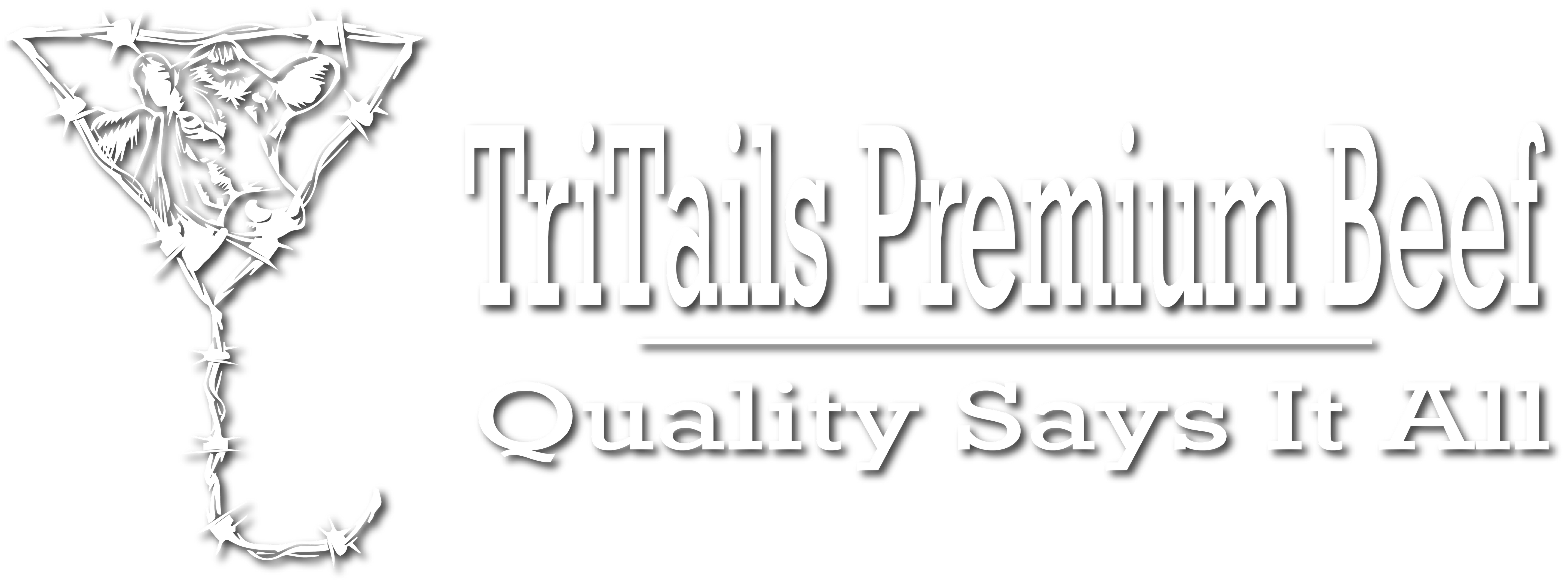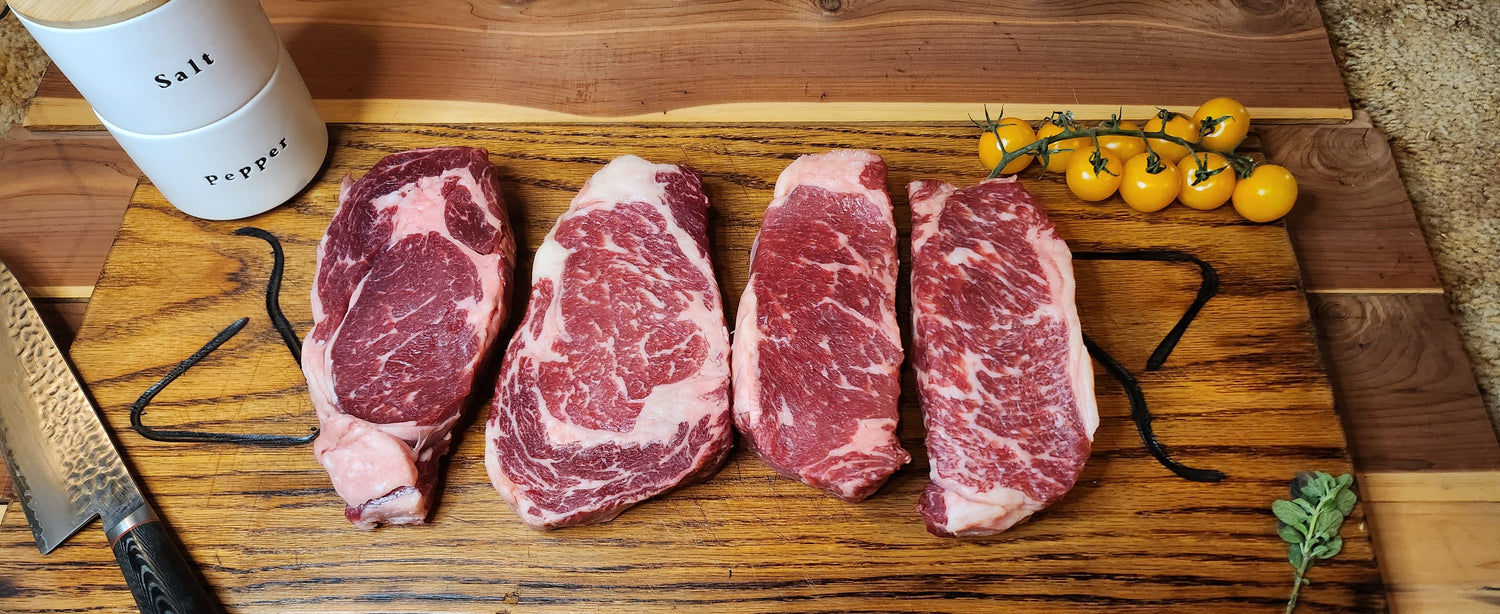Today I pondered what I should write about for this month's newsletter. There are many things to discuss when running a ranch, and I still want to share a lot with my readers. There is one thing I realized that needs to be addressed, considering that we are a beef distributor, and that is BEEF! I want to inform you about some things that will improve your steak life.

Before you buy
One of the first things you should ask about when buying a steak is what makes a steak good. The answer lies within many different variables. Everything from how you cook your steak to how you season it is crucial. As someone who has been selling steaks over the past few years, I have learned that eating steak is a personal preference. Almost everyone likes something a little different. Whether that is a cooking style, cut of steak or sauce, or no sauce. However, there is one thing that is for sure a fact; without an excellent raw cut of steak, you will never have a good meal. It all starts with quality ingredients; without that, you are doomed before you even start.
So, what makes a piece of beef good right from the start? We need to go back to the steaks beginning the animal. Even so far back as to when the animal was bred. A good steak starts with good animal genetics. First, we need to start with the type of cattle that you are about to eat. There are many breeds, including Herefords, Charolais, Limousin, Brahman, and the famous Wagyu. However, at TriTails, we have found that one breed stands above them all: the Black Angus. Where the Wagyu can almost have too much marbling and even be greasy; the Herefords don't have enough, but the Black Angus is the perfect mix of delicious marbling and meaty flavor.
Now that our breed is chosen, we need to find good genetics. Genetics has largely been ignored by consumers in the steak world. In fact, until recently, there was no way for a consumer to learn about the genetics of the beef they are consuming. When one goes to the grocery store, you choose from a wide variety of potential genetics. However, with the introduction of the ranch to table beef, one can start to understand genetics. That is because a rancher will sell you only their beef from the same line of cattle genetics, and here is why you should care. Some genetics are simply better than others. Good cattle will be healthier and put on weight better. They will be calmer and, in general, happier. Good genetics is also great for preventing disease in animals. All of that correlates to consistently getting a great steak.
Okay, we have a suitable breed and good genetics in a ranch-to-table relationship. What's next is how the rancher cares for the animal and what that animal eats. Good beef cattle puts on weight early in its life and keeps it on till it becomes steaks. Weight is similar and different to humans. For instance, no one likes to see a skinny baby. Babies should be a little chunky, and so should calves. Unlike humans, though, a fattened adult is also good for cattle, and this is due to their diet.
Grass-fed cattle will generally lack marbling as it will not sufficiently fatten the animal. The result is a challenging leathery piece of meat. In the same way, grain-fed only cattle will have too much marbling and often a funny taste. Even though these cows are well-fattened, they may not have developed the meaty goodness we want in a steak. So, what is the best diet for cattle? The answer is precisely what we do at TriTails. Cattle that graze grass all their lives with some grain snacks in between. Then right before the cow becomes delicious steak, we move the cow to a grain-finished diet. This helps bring out the marbling and reduces that typical "gamey / grassy" flavor you might find in grass-fed only cattle.
How the rancher cares for the animals is also essential. Are they growing nutritious grass for the animals? Is the rancher keeping stress off the animals by treating them kindly and being calm around them? Stress factors like poor pasture land and rough housing the animal can quickly take its toll on the animal and, inevitably, the quality of beef.

As you can tell, a lot goes into raising cattle. Often so much of this is hidden from public sight. Most people buying beef from the grocery store are uneducated about beef, and worse, don't even know the origins of the animal. With the future of ranch to table, the world of beef is changing. Many people have a favorite mechanic to fix their car, a favorite doctor to keep them healthy, or a favorite accountant to pay their taxes. They know these professionals can deliver time and time again, and that's why they stick with them. Now it's time to get that personal connection with where your food comes from.
At TriTails, we are a multi-generational Texas ranch with the goal to deliver our customers some of the best steaks consistently on the market, time and time again. It is time to get to know your rancher.
What to buy
Now that you know that grocery store beef will not make the cut, it is time to buy a delicious TriTails Steak. There is still one problem, what cut do you buy with so many delicious options? Don't worry; I'm here to help you with the expertise with my fellow ranching family who have my back. The best part of eating steak is there are so many ways to do it, and there is a specific cut for just about any occasion.
The Steaks
The Ribeye
One of the most loved steaks of all time, the ribeye is to classic go-to when people think of steak. The ribeye comes from the rib part of the cow (get it, "Rib-eye!"). Usually, it is specifically taken from between the sixth and twelfth ribs. The cut of meat is tender due to its well-marbled properties. If you are not a fan of chewy steaks, then a well-marbled ribeye may well be your solution. The ribeye also has a bit of fat around the edges and at the cap. Some people choose to cut it off when eating the steak, but keeping it is not a bad thing. Perfect for cooking, this fat renders out into the steak giving it plenty of flavors and keeping it moist for a juicy bite. In fact, Helen, Sam, and Faith's favorite part of the ribeye is that juicy cap, and when eating this steak, will devour this part first! Ribeyes are great on the grill or seared on a cast iron. It is the show's star, so keeping it simple goes a long way—no need to marinate or do any fancy rubs. Let the quality of the steak speak for itself.
The N.Y. Strip
The N.Y. Strip or Strip is another infamous cut. It comes from the short loin portion of the cow. This cut is often thicker than the ribeye and is left with a fat cap on its side. This cut is not as tender as the ribeye but has redeeming qualities. This cut is for you if you like a steak more on the rare side. With its thick cut, you can get that perfect pink juicy center. The fat cap on the side renders out into the steak as you cook it adding flavor and juices. When you see juicy steak in the dictionary, there is a picture of a Strip next to it. With TriTails Strip, you don't have to worry about a chewy steak. Our Strips are well-marbled and ready for your grill or cast iron. These steaks are perfect for a reverse sear, if that's your thing
The Filet
The Filet is steak gold. Filets are the most expensive cut on the animal, but that is not without good reason. The Filet comes from the short loin but from an even more tender area called the Tenderloin. Oddly enough, the tenderloin is the hardest part of the animal to get marbled as it's marbling is the first to go when under states of stress. Fortunately, here at TriTails, we have a science to taking good care of our animals!
The Filet is known for its flavor, but none come close to its tenderness. If cooked correctly, a TriTails filet can be cut without a knife. This cut is perfect for dinner parties where you need to impress. Men take note that a woman will be blown away if you cook her one of these on date night. Many people like to grill these steaks, but they are perfect for a sear in the cast iron and then finished in the oven. Pair it with some wine, and be prepared to take a trip to Tastyville.
The Porterhouse and T-Bone
While the last steak is perfect to pair with wine, these guys are perfect with a beer. The Porterhouse and the T-bone come from the Short Loin portion of the cow. They are identified as almost the same cut. They are both bone in N.Y. strips, but they hang out so close to the Tenderloin that a filet is on the other side of that bone. The difference is that the porterhouse has a much more significant amount of Filet than the T-Bone. The porterhouse will have the whole 8 oz of the Filet, and the T-Bone will have 1 to 4 oz. These also have the advantage of being bone-in products. The bone is good, holding in juices and keeping the beef tender. Do you know why you love ribs? It's because it is close to the bone, being kept tender and juicy.
The Denver/Flat Iron Steak
Very much the same steak, the flat iron or Denver steak, comes from the chuck shoulder portion of the cattle. It is a very misunderstood steak and often overlooked. Due to it's location in the shoulder, it is a muscle that is heavily used. This said, it is cut thinly to compensate for the toughness built from use (walking, etc). However, it is an excellent steak if you can overcome the thinness. The flat iron is much less expensive than other steaks and can have a similar feel as a more expensive steak. In my experience, this steak has a unique flavor profile that I am quite a big fan of. It is also on the leaner side, similar to a sirloin steak. If you are not a fan of fat, then this is a beautiful steak for you to try.
The Sirloin Steak
The sirloin steak is the favorite of many steak fans, and that does not go without reason. It is a lean cut that comes from the cow's back. It is lean, which often means that people looking to lose weight or bulk up on protein indulge in this cut. It has an excellent flavor profile and should not be overlooked. Sirloins are great steaks to make other recipes with or eat at other meals than breakfast. Prepare for chicken fried steak or steak and eggs!
Picanha aka Coulotte aka Top Butt-Cap on
Picanaha has recently become popular in America after getting its start in Brazil. This steak comes from the rump portion of the cow and is a high-end version of the sirloin steak. What makes this steak so unique is the fat cap that is left on the steak. You can think of this as similar to the N.Y. Strip in that you can now render fat into the steak. Although this cut is similar to the sirloin, it also comes from a more specific region of the cow that is more tender and flavorful. Picanha can be cooked like any other steak, but to maximize the flavor potential of this cut, we recommend doing it the the Brazilian way: indirect heat to start, and fire kissed to finish.
Cuts and Grinds For Recipes
Skirt Steak
Although the name of this cut has the word steak, you would not indulge in this cut as a regular steak. Coming from the plate portion of the cow, the skirt steak has been made famous by the infamous fajita. In fact, this cut was hardly used and often turned into ground beef until the fajita became popular in the U.S.
Ground Beef
The most versatile thing that you can do with beef. Ground beef is the ultimate way to "beef up" any meal. Use it for anything from stuffed peppers to full-out meatloaf's you will never grow board cooking. At TriTails, our ground beef will stick out a notch compared to others. That's because we use aged ground chuck for our grind rather than the trim that many other beef distributors provide.
Kabob
We have several different names for this product, including kabob, stir fry meat, and steak tips. When steaks are cut to their proper size and shape, a bit of excess tasty steaks often come off. These become delicious steak bites. Steak tips are amazing for a versatile array of recipes. These include stir fry and kabobs but also include things like stews and sauces. One of my favorites is to put it in a pasta sauce versus using meatballs. These are a great way to get a hold of a steak product at a cheaper cost.(recipe)
Tenderloin Tips
The Tenderloin tip is little delicious pieces of steak from the Tenderloin. These are all the leftover pieces of steak from our delicious filets. These guys are a great way to make those buttery tender tenderloin tips for a great price.
Chuck Ribs
The Chuck Ribs come from the rib portion of the cow, and they are one of our most popular products. These ribs are massive, weighing up to one pound per rib. Make your next bbq one to remember with these big beefy boys. Bye Bye wimpy pork ribs, hello beef ribs! (recipe)
Now that you have a general idea of what our cuts are best used for, we would love to hear what your favorite TriTails cut is and how you like to prepare it. If you have any questions, don't hesitate to reach out as we are here to serve (quality beef)!







3 comments
Brian
That was quite the education on beef I feel like arguing with the butcher now !.I been getting your emails for a while now maybe it’s time I your Beek
Brian
That was quite the education on beef I feel like arguing with the butcher now !.I been getting your emails for a while now maybe it’s time I your Beek
John Jones (Virginia_Peanut on GAB)
Excellent article, Conner! Great job. I have learned more about beef since buying my steaks at TriTails than I ever have. Thanks
Leave a comment
All comments are moderated before being published.
This site is protected by hCaptcha and the hCaptcha Privacy Policy and Terms of Service apply.